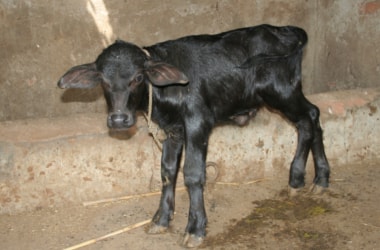
Vijay is the name of the country’s first calf delivered by a surrogate or recipient cow through In Vitro Fertilisation (IVF) technology carried out in a mobile laboratory.
In the past few years, indigenous cow breeds have been destroyed due to cross-breeding.
While in human beings, IVF technology comes to the aid when either of the couple is infertile, in the case of cows, our objective is to protect the breed in its original form.
In its lifetime (15 years on an average), a cow gives birth to 10 calves at the most.
Through IVF technology, it can give birth to 20 calves in a year through recipient cows, which means nearly 200 in its lifetime.
About 50 embryos can be produced by a donor cow in a year.
A similar experiment was carried out about five years ago by the National Dairy Research Institute at the lab-level.
This is the first time that the procedure was successfully implemented at a farm, with the help of a mobile laboratory.
The aim is to take the technology to the farmer.
The scientists carry out the entire procedure in front of the farmer, with their mobile IVF lab,
In Vijay’s case, the donor cow, Ratan, belongs to the Gir breed, whose population across the country is around one lakh currently.
Unevenly spread across Gujarat, Rajasthan and Maharashtra, on an average, it gives 10-12 litres of milk daily.
Under the JK Trust’s initiative, JK BovaGenix, aimed at promoting genetically superior indigenous cattle breeds, the oocytes, or immature eggs, of the donor cow were collected.
The oocytes were kept in a special incubator, which worked as an artificial uterus, for nearly 24 hours.
Meanwhile, semen was collected from a Gir bull. The process of fertilisation then began - in a petri dish inside the incubator, at a temperature of 38.5 degree centigrade.
After seven days, the oocytes developed into an embryo, which was transferred to the recipient cow.
The oestrus cycle in cows occurs every 21 days.
The embryo can be transferred to the cow seven days before its oestrus cycle. Its body will then accept it as its own embryo and the chances of pregnancy will increase.
Additionally the success rate of IVF technology in cows is 40 per cent and the procedure can be done on the donor cow at least 10-12 times in a year.
Other than Ratan, the oocytes of three more donor cows - one Gir breed and two Khillar breed - were collected in November.
The other three surrogate mother cows are due to give birth in the next two weeks.
Similarly, the oocytes of three cows (Tharparkar breed) that belong to Chandrakant Bharekar, who owns another ‘cow farm’ near Pune, were also collected.
The embryos were transferred to recipient cows in November.
These surrogate mother cows are expected to give birth this week.
At present, JK Trust has two state-of-the-art Embryo Transfer and IVF laboratories, known as Dr Vijaypat Singhania Centre of Excellence Assisted Reproductive Technologies in Livestock.
This is at Gopalnagar, near Bilaspur, in Chhattisgarh and Vadgaon-Rasai near Pune.